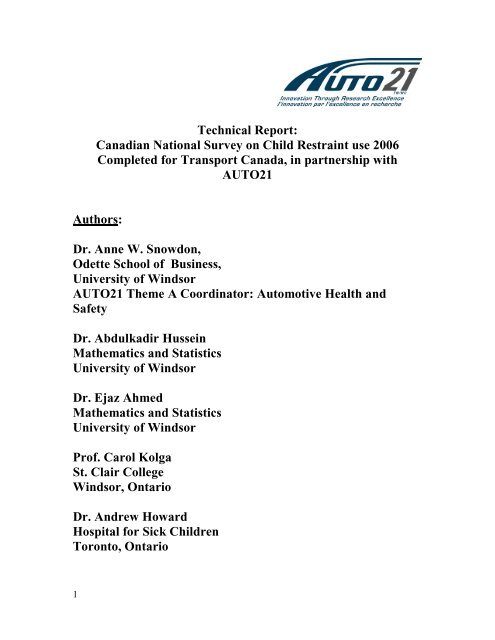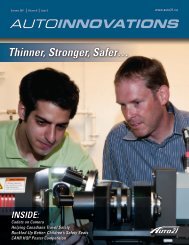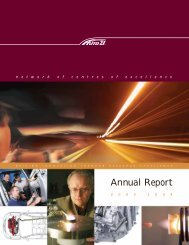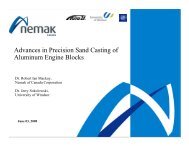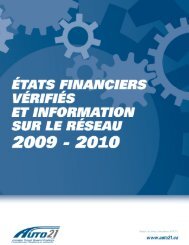You also want an ePaper? Increase the reach of your titles
YUMPU automatically turns print PDFs into web optimized ePapers that Google loves.
explained the purpose of the study, invited the driver to participate and for thosedrivers who agreed, then directed them to the observation area. If the driverdeclined to be apart of the survey, the observer completed the non-participantsurvey form for the vehicle to identify gender of driver, belted status of driver,number /type/ restraint status of occupants. This data was collected by theinterceptor only for those drivers who declined to participate in the parking lotsurvey to ensure there would be no duplication of data entry on child occupantstatus.The Parking Lot Survey continued with a detailed inspection of child seatrestraint use and included a brief interview with the driver. Following the pilottesting of the survey protocol it was determined that a two member team couldmove through the parking lot data collection rapidly to minimize the time requiredof the driver to complete the data collection. One of the team members greetedthe driver in the observation station and obtained written consent for participationand ensure a copy of the consent was given to the driver. The second membertook down the first ten digits of the vehicle identification number (VIN) andrecorded the seating position and restraint use of each of the child occupants 14years of age or under. Height and weight measurements were completed foreach child occupant who was willing to participate in this component of thesurvey. Parents were asked to remove the child from the vehicle and observewhile the height and weight was measured. The data collection time to completeall the entries varied between 10 and 20 minutes depending on how manyoccupants were in the vehicle and how many questions parents asked observers.All data was recorded on a paper copy of the observation survey instrument.When the survey was completed the team provided a sticker for each child whohad participated and the driver was provided with Transport Canada Child Safetyinformation that corresponded to the car seat their child was using or shouldhave been using. In all cases, the data were obtained from the driver or adultoccupant. The survey was administered by a survey team of 8 pre-traineduniversity students or adults.Through teleconference, video taping, powerpoint presentations, and emailcommunication team leaders and their data collectors received 4 hours of paideducation and training prior to commencing the survey. Telephonecommunication was maintained between team leaders and the principalinvestigator throughout the data collection phase of the study. All decisionsregarding changes or unexpected events that occurred during data collectionwere made by the principal investigator to ensure consistency of surveyprocedures.2.4 InstrumentThe instruments used for this National Child Seat Survey were updated versionsof the survey instruments used in the 1997 survey. The roadside intersectionobservation survey tool was used in the same format it had been developed for7
previous surveys. The instrument developed specifically for the parking lot surveywas developed in collaboration with Transport Canada and the leadinvestigators. The format and content of the survey tool closely resembled a childseat inspection form used in child seat clinics. In addition, the demographic datathat describes the seating position and the age, height and weight of each childoccupant had been used for previous National Surveys by Transport Canada.The interview instrument is a subset of questions for the survey instrument usedin the Intervention study recently conducted by Dr. Anne W. Snowdon at theUniversity of Windsor. The interview questions focused on drivers’ knowledgeand awareness of when to transition children into the next child seat, a boosterseat and a seat belt. Drivers also reported on their patterns of where childrentypically sit in the vehicle. The combination of both observation and interviewstrategies will provide data on exactly how families are using safety seats forchildren across Canada and what knowledge they have of accurate use of safetysystems for children travelling in vehicles. The combination of observation ofuse/misuse and examination of parent knowledge provided data linkingknowledge and use of safety systems, for the first time in Canada, at a Nationallevel. This study will examine the following questions: a) What are the patternsand rates of use and misuse of safety seats for child occupants travelling invehicles in Canada? b) What are drivers' knowledge and perceptions of correctuse of safety systems for children travelling in vehicles across Canada?3. Results3.1 General commentsIn total, out of the 200 sites planned for, 16 were dropped either due to storms orremoteness of the sites. These sites are described in table-A below. Droppingthe only two sites assigned to the Yukon territory resulted in deletion of 4185children from the sampling frame which consisted of all children aged 0-17 yearsin Canada according to statistics Canada’s 2004 census.Table-A:Dropped SitesFrequencyAbitibi - Témiscamingue 2Bas-Saint-Laurent2Hamilton - Niagara Peninsula1Kitchener - Waterloo - Barrie1Lanaudière128
MontérégieNorthTorontoYorkton - MelvilleYukon TerritoryTotal212216Management of 38 parking lot sites declined to participate and therefore, thesesites did not contribute any observations. In total, there were 1697 vehicles in theparking lot data for which at least one variable was recorded and 3424 vehicleswhose drivers refused to participate in the survey and for those, driver’s gender,restraint status, number of children in the vehicle and their restraint status wererecorded.In the roadside data, there were 10084 vehicles for which at least one variable isobserved. These were collected on 184 sites out of the 200 sites sampled forthis study.Correct use of child safety seat was defined based on child's age alone, weightalone and combined age, weight and height. The definitions are displayed in thefollowing Tables B, C and D. We have not found any unified and simple criteriafor guiding parents to the correct use of safety seats for their children. Most of theguidelines found seem to have non-exclusive/non-exhaustive classes whendefining the age, weight and height groups for the various child seat types. Thiscreates either redundancy or gaps so that some children do not actually fall inany of the categories and parents are left confused. Our Table B is an efforttowards such a unified definition.Table-B: Definition of Correct safety system based on the child’s age,weight and height groups.Types of SeatVariables:Rear-facing Infant SeatForward-facingInfant SeatBooster SeatSeatbelt Only9Age, Weight and Height Groups(Age
Table-C: Definition of Correct safety system based on the child’s weightgroups.Types of SeatRear-facing Infant SeatForward-facing Infant SeatBooster SeatSeatbelt OnlyVariables: Weight GroupsWeight
Figure 3.2.1: Box plots showing median age in months per provincerepresented by the middle bar in each box).250.00200.00Child's age in months150.00100.0050.000.00ABBCMBNBNFLNSNTONPEIQCSKProvince__Only 1811 children had their actual weights recorded (see Table 3.2.1) whereasparent’s estimation of the child’s weight was recorded for 2285 children. Table3.2.1 shows the distribution of weight classes for either actual or estimated. Thehighest proportion of children falls in the weight group (40-80] lbs (41.0%, 38.1%for actual and actual/estimated, respectively), while the lowest proportion falls inthe weight group (0-20] lbs (4.2%, 7.9% for actual and actual/estimated weights,respectively).The measures of children’s height differed from the trend of measuring children’sweight.. More children had their actual heights measured than estimated. In fact,there were 1723 children with actual heights and 1240 with estimated heights.53.5% and 50.2% of the children fall in the height group (40-57] inches for actualand actual/estimated respectively (see Table-3.2.1). Anecdotally, parents hadless awareness of their child’s height than they had for their child’s weight.Both for height and weight, the estimated and actual values were highlycorrelated (see Figures 3.2.2 & 3.2.3) and their respective, un-weighted, Pearsoncorrelations are: 0.909 and 0.966. This may suggest using the estimated weightsor heights whenever the actual values of these variables are not available. Theheight scatterplot shows some outliers. The data is correlated within each vehicle11
as the children in a given vehicle may likely be from the same household and theestimated correlations are not adjusted for such correlation trends within families.Figure 3.2.2: A scatter plot of the actual vs. estimated weights of children inthe sample.250.00200.00Child #1 - Estimated weight150.00100.0050.000.000.0050.00100.00150.00200.00250.00Child #1 - Actual weight12
Figure 3.2.3: A scatter plot of the actual vs. estimated heights of children inthe sample.80.00Child #1 - Etimated height60.0040.0020.0020.0030.0040.0050.0060.0070.0080.00Child #1 - Actual heightAmong the children whose age was recorded, 90.4% were older than 12 monthsof age and 36.5% were in the age group (4-9] years (see Table-3.2.1).Restraint status, seat types and other relevant variables:Table 3.2.2 & 3.2.3 report the distributions of child’s restraint status, seat types,gender and relationship to the driver.Table-3.2.1: Child’s age, weight and height groups.Category Actual Actual/EstimatedFrequency Percent Frequency PercentWeight Groups 1811 100% 2452 100%< or = 20 lbs 76 4.2% 193 7.9%(20 – 40] lbs 602 33.2% 865 35.3%(40 – 80] lbs 743 41.0% 933 38.1%> 80 lbs 390 21.5% 461 18.8%Height Groups 1723 100% 2101 100%< or = 40 inches 481 27.9% 679 32.3%(40 – 57] inches 921 53.5% 1055 50.2%> 57 inches 321 18.6% 367 17.5%13
Age Grouping 1(months) 2436 100%< or = 12 months 234 9.6%> 12 months 2202 90.4%Age Grouping 2(months) 2436 100%0 – 6 months 109 4.5%7 – 12 months 125 5.1%1 years old 217 8.9%2 years old 221 9.1%3 years old 220 9.0%4 years old 205 8.4%5 years old 206 8.5%6 years old 169 6.9%7 years old 161 6.6%8 years old 149 6.1%9 years old 169 6.9%10 years old 145 6.0%11 years old 135 5.5%12 years old or above 205 8.4%Age grouping 3(in years) 2436 100%< or = 1 year 234 9.6%(1 – 4] years 658 27.0%(4 – 9] years 890 36.5%> 9 years 654 26.8%Table-3.2.2: Child’s restraint status and type restraint.Category Frequency PercentRestraint Status 2473 100%Yes 2451 99.1%No 22 0.9%Types of safety seats2447 100%Rear-facing Infant Seat 239 9.8%Forward-facing Infant Seat 645 26.4%Booster Seat 596 24.4%Seatbelt Only 967 39.5%14
Table-3.2.3: Child’s gender and relationship to the driver.Category Frequency PercentChild’s Gender 2195 100%Male 1145 52.2%Female 1050 47.8%Child-Driver Relationship 2306 100%Parent / Foster 2084 90.4%Grandparent 128 5.6%Other family 47 2.0%Other 47 2.0%Distributions of correct use based on the criteria in Tables B, C & D:Tables 3.2.4-3.2.11, report nationwide and provincial percentages of childrenwho are in the correct systems based on the criteria in Tables B,C and D.Table-3.2.12 reports the percentages of children using each seat type bydifferent age groups. The asterisk indicates a conservative correct use criteriawhereby, the child is only guarded from pre-mature transition to the next type ofsafety seat.Table-3.2.4: National distribution of correct use of child safety systemsbased on actual and actual/estimated weights and heights, and according tothe criteria in Table B.Category Actual Actual/EstimatedFrequency Percent Frequency Percent1837 2277Incorrect use 743 40.4% 914 40.1%Correct use 1094 59.6% 1363 59.9%Table-3.2.5: Provincial distribution of correct use of child safety systemsbased on actual weights and heights, and according to the criteria in Table B.Province Category TotalIncorrect use Correct useAlbertaCount 84 140 224% within Province 37.5% 62.5% 100.0%15
British ColumbiaCount 95 125 220% within Province 43.2% 56.8% 100.0%ManitobaCount 23 25 48% within Province 47.9% 52.1% 100.0%New BrunswickCount 73 138 211% within Province 34.6% 65.4% 100.0%NewfoundlandCount 43 65 108% within Province 39.8% 60.2% 100.0%Nova ScotiaCount 74 101 175% within Province 42.3% 57.7% 100.0%Northwest TerritoriesCount 12 7 19% within Province 63.2% 36.8% 100.0%OntarioCount 204 372 576% within Province 35.4% 64.6% 100.0%Prince Edward IslandCount 43 28 71% within Province 60.6% 39.4% 100.0%QuebecCount 69 58 127% within Province 54.3% 45.7% 100.0%SaskatchewanCount 23 35 58% within Province 39.7% 60.3% 100.0%TotalCount 743 1094 1837% within Province 40.4% 59.6% 100.0%16
Table-3.2.6: Provincial distribution of correct use of child safety systemsbased on actual/estimated weights and heights, and according to the criteriain Table B.Province Category TotalIncorrect CorrectAlbertaCount 94 172 266% within Province 35.3% 64.7% 100.0%British ColumbiaCount 107 143 250% within Province 42.8% 57.2% 100.0%ManitobaCount 30 32 62% within Province 48.4% 51.6% 100.0%New BrunswickCount 107 193 300% within Province 35.7% 64.3% 100.0%NewfoundlandCount 76 88 164% within Province 46.3% 53.7% 100.0%Nova ScotiaCount 95 142 237% within Province 40.1% 59.9% 100.0%Northwest TerritoriesCount 13 12 25% within Province 52.0% 48.0% 100.0%OntarioCount 236 438 674% within Province 35.0% 65.0% 100.0%Prince Edward IslandCount 49 36 85% within Province 57.6% 42.4% 100.0%QuebecCount 83 69 152% within Province 54.6% 45.4% 100.0%SaskatchewanCount 24 38 62% within Province 38.7% 61.3% 100.0%TotalCount 914 1363 2277% within Province 40.1% 59.9% 100.0%17
Table-3.2.7: National distribution of correct use of child safety systemsbased on actual and actual/estimated weights and heights, and according tothe criteria in Table C.Category Actual Actual/EstimatedFrequency Percent Frequency Percent1789 2418Incorrect use 659 36.8% 846 35.0%Correct use 1130 63.2% 1572 65.0%Table-3.2.8: National distribution of correct use of child safety systemsbased on actual weights and heights, and according to the criteria in TableC.Province Use of Combined Restraint TotalAccording to Actual WeightGroupsIncorrect CorrectAlbertaCount 80 129 209% within Province 38.3% 61.7% 100.0%British ColumbiaCount 88 134 222% within Province 39.6% 60.4% 100.0%ManitobaCount 22 21 43% within Province 51.2% 48.8% 100.0%New BrunswickCount 64 141 205% within Province 31.2% 68.8% 100.0%NewfoundlandCount 29 72 101% within Province 28.7% 71.3% 100.0%Nova ScotiaCount 65 91 156% within Province 41.7% 58.3% 100.0%Northwest TerritoriesCount 9 9 18% within Province 50.0% 50.0% 100.0%18
OntarioCount 179 397 576% within Province 31.1% 68.9% 100.0%Prince Edward IslandCount 36 31 67% within Province 53.7% 46.3% 100.0%QuebecCount 63 66 129% within Province 48.8% 51.2% 100.0%SaskatchewanCount 24 39 63% within Province 38.1% 61.9% 100.0%TotalCount 659 1130 1789% within Province 36.8% 63.2% 100.0%Table-3.2.9: Provincial distribution of correct use of child safety systemsbased on actual weights and heights, and according to the criteria in Table C.Province Use of Combined Restraint TotalAccording to Actual/EstimateWeight GroupsIncorrect CorrectAlbertaCount 93 193 286% within Province 32.5% 67.5% 100.0%British ColumbiaCount 107 170 277% within Province 38.6% 61.4% 100.0%ManitobaCount 27 37 64% within Province 42.2% 57.8% 100.0%New BrunswickCount 104 212 316% within Province 32.9% 67.1% 100.0%NewfoundlandCount 63 103 166% within Province 38.0% 62.0% 100.0%Nova ScotiaCount 88 155 243% within Province 36.2% 63.8% 100.0%Northwest TerritoriesCount 10 18 28% within Province 35.9% 64.3% 100.0%19
OntarioCount 210 514 724% within Province 29.0% 71.0% 100.0%Prince Edward IslandCount 42 44 86% within Province 48.8% 51.2% 100.0%QuebecCount 78 83 161% within Province 48.4% 51.6% 100.0%SaskatchewanCount 24 43 67% within Province 35.8% 64.2% 100.0%TotalCount 846 1572 2418% within Province 35.0% 65.0% 100.0%Table-3.2.10: National distribution of correct use of child safety systemsbased on age groups (group 3 in Table 3.2.1) and according to the criteria inTable D.Category Frequency Percent2402Incorrect use 514 21.4%Correct use 1888 78.6%Table-3.2.11: Provincial distribution of correct use of child safety systemsbased on age groups (group 3 in Table 3.2.1) and according to the criteria inTable D.Province Correctness of Seat UsedTotalAccording to Age Group 3Incorrect use Correct useAlbertaCount 59 227 286% within Province 20.6% 79.4% 100.0%British ColumbiaCount 55 218 273% within Province 20.1% 79.9% 100.0%ManitobaCount 16 47 63% within Province 25.4% 74.6% 100.0%New BrunswickCount 76 241 317% within Province 24.0% 76.0% 100.0%20
NewfoundlandCount 45 121 166% within Province 27.1% 72.9% 100.0%Nova ScotiaCount 49 188 237% within Province 20.7% 79.3% 100.0%Northwest TerritoriesCount 8 19 27% within Province 29.6% 70.4% 100.0%OntarioCount 114 603 717% within Province 15.9% 84.1% 100.0%Prince Edward IslandCount 28 56 84% within Province 33.3% 66.7% 100.0%QuebecCount 47 115 162% within Province 29.0% 71.0% 100.0%SaskatchewanCount 17 53 70% within Province 24.3% 75.7% 100.0%TotalCount 514 1888 2402% within Province 21.4% 78.6% 100.0%Table-3.2.12: Restraint type by age groupCategoryTypes of Combined RestraintAge in Years Rear-facing Forward-facing Booster Seat BeltGroup 3 Infant Seat Infant Seat Seat Only TotalInfant N = 181* N = 52 N = 1 N = 0 234 9 years 0.0% 0.0% 2.5% 97.5%Total 230 633 584 955 2402* indicates correct use based on most conservative criteria of age (infants),height, and weight21
3.3 Descriptive Statistics for the sample of drivers in the Parkinglot dataTable 3.3.1 provides driver’s restraint status along with some demographic andsocio-economic characteristics. Of the 1668 drivers whose restraint status wasrecorded, close to 98% were observed using a seat belt. 50% of the drivers were30-39 years old, about 62% were females, 91% were either married or hadcommon law partner and 86.1% were Caucasian. English was the languagespoken by 80.7% of the drivers observed in this parking lot. Education andincome levels were reported as followis: 36.4% had University level educationand 43.2% had income $40000-$80000. About 40% of the drivers reported livingin large cities.Driver’s restraint status according to age, gender, marital status, education level,income, and city size are reported in Tables 3.3.2 to 3.3.7. It seems thatpercentage of seat belted drivers was high among females, older age groups,higher education groups, higher incomes brackets and drivers in larger cities.Table-3.3.1: Driver’s information.Category Frequency PercentSeat Belt Status 1668Belted 1637 98.1%Unbelted 31 1.9%Age 167320-29 Years 246 14.7%30-39 Years 838 50.1%40-49 Years 448 26.8%50-60 Years 96 5.7%Over 60 Years 45 2.7%Gender 1672Male 632 37.8%Female 1037 62.0%Unsure 3 0.2%Marital Status 1607Married/common law 1460 91%Separated/divorced 131 8%widowed 16 1.0%22
Race/Ethnicity 1652First Nations 39 2.4%Asian 45 2.7%Arabic 11 .7%Indo-Canadian 22 1.3%Caucasian 1423 86.1%African Canadian 7 .4%Hispanic 15 .9%Other 90 5.4%Missing 45Language 1672English 1350 80.7%French 170 10.2%Other 152 9.1%Missing 25Education Level 1645Elementary school 10 .6%Some high school 82 5.0%High school graduate 325 19.8%Some college/university 264 16.0%College graduate 404 24.6%University 560 34.0%Missing 52Income 1554Under $40,000 318 20.5%$40,000 - $80,000 671 43.2%Over $80,000 565 36.4%Missing 143Living Status 1668Large city(over 100,000) 666 39.9%Large town or small city(10,000-100,000) 544 32.6%Small town(under 10,000) 458 27.5%Missing 2923
Table-3.3.2: Seat belt status by driver’s age.24CategorySeat Belt StatusAge Belted UnbeltedTotal20-29 Years 236(96.7%) 8(3.3%) 24430-39 Years 818(98.2%) 15(1.8%) 83340-49 Years 440(98.7%) 6(1.3%) 44650-60 Years 95(99.0%) 1(1.0%) 96Over 60 Years 45(100.0%) 0(.0%) 45Total 1634(98.2%) 30(1.8%) 1664Table-3.3.3: Seat belt status by driver’s gender.CategorySeat Belt StatusGender Belted UnbeltedTotalMale 613(97.6%) 15(2.4%) 628Female 1016(98.4%) 16(1.6%) 1032Unsure 3(100.0%) 0(.0%) 3Total 1632(98.1%) 31(1.9%) 1663Table-3.3.4: Seat belt status by driver’s education level.CategorySeat Belt StatusEducation Level Belted UnbeltedTotalElementary school 9(90.0%) 1(10.0%) 10Some high school 78(95.1%) 4(4.9%) 82High school graduate 318(99.4%) 2(.6%) 320Some college/university 252(96.2%) 10(3.8%) 262College graduate 393(97.5%) 10(2.5%) 403University 555(99.3%) 4(.7%) 559Total 1605(98.1%) 31(1.9%) 1636Table-3.3.5: Seat belt status by driver’s income.CategorySeat Belt StatusIncome Belted UnbeltedTotalUnder $40,000 308(97.8%) 7(2.2%) 315$40,000-$80,000 647(97.1%) 19(2.9%) 666Over $80,000 560(99.3%) 4(.7%) 564Total 1515(98.1%) 30(1.9%) 1545
Table-3.3.6: Seat belt status by population size of driver’s community.CategorySeat Belt StatusLiving Status Belted UnbeltedTotalLarge city(over 100,000) 657(98.9%) 7(1.1%) 664Large town or small city(10,000-100,000)531(98.0%) 11(2.0%) 542Small town(under10,000)440(97.1%) 13(2.9%) 453Total 1628(98.1%) 31(1.9%) 16593.4 Weighted Estimates of Various Correct Variables for theParking Lot DataIn what follows we carry out weighted analysis of correct use rates based onsurvey methodology. Here we give a summary of the estimation procedure:The sampling frame was stratified by province and by region, according to theStatistics Canada’s definition of census regions (see Chounard, 2004). The totalpopulation of children younger than 17 years per province and per region withinprovince for the year 2004 was extracted from Statistics Canada’s data base byAline Chouinard of Transport Canada. Let h=1,…,m indicate the strata (region)within a given province, where m indicates the total number of regions in theprovince. Within each region we are ignoring the lower sampling stages such asthe intersection, the day of the week and the sampling time within a given day.The randomizations of those stages were largely violated due to practicality. Wehave opted to use a post-stratification procedure. Thus, we are assuming inwhat follows that, within each region in a province, the sample of vehiclesobserved at all sites in that region form a simple random sample withoutreplacement (SRSWOR). Also, in each vehicle observed there were a number ofchildren whose variables were recorded. Therefore, the vehicle forms a clusterand gives rise to correlated observations. Let i=1,..,m h indicate the i th clusterwithin the h th strata so that m h indicates the total number of vehicles observedwithin the h th strata. Finally, let j=1,…,m hi denote the j th observation (child) withinthe i th vehicle in the h th region (strata), so that m hi denotes the total number ofchildren (up to 3) in the i th vehicle observed in the h th region. First we obtainestimates of correct use for each region within a province and then we combinethese regional estimates to give a provincial estimate by using weightsproportional to the size of the region. That is, the region weights are equal to thechild population size of the province divided by the child population size of theregion. This amounts to assigning a weight of w = N / n to the observation ofhij h h25
the j th child in the i th vehicle of the h th region which is equal to the population sizeof the region divided by the actual sample size collected on the variable ofinterest in that particular region.To obtain the national weighted estimates, we combine the provincial estimatesusing weights equal to the national child population size divided by provincialchild population sizes. It is to be noted that both in the regional and provincialweights the child population sizes refer to the regions which have actual samplespresent in the data.The standard errors of the estimates were computed by Taylor expansionmethod and most of the analysis was carried with the help of the PROCSURVMEANS of the SAS software.The provincial as well as national weighted estimates of the correct use based onthe criteria in Tables B, C & D are reported in Tables 3.4.1-3.4.10.Table-3.4.1: National weighted estimates of correct use based on child’sage, actual weight and actual height and on the criteria in Table B.26Proportion Estimate StandardError95% ConfidenceIntervalLower UpperNational 59.6% 60.18% 1.92% 56.41% 63.95%Table-3.4.2: Provincial weighted estimates of correct use based on child’sage, actual weight and actual height and on the criteria in Table B.Province Proportion Estimate StandardError95% ConfidenceIntervalLower UpperAlberta 62.5% 59.19% 5.72% 47.89% 70.49%BritishColumbia56.8% 64.66% 5.12% 54.54% 74.77%Manitoba 52.1% 58.34% 12.08% 33.74% 82.94%NewBrunswick65.4% 64.38% 4.26% 55.96% 72.79%Newfoundland 60.2% 56.75% 6.32% 44.17% 69.33%Nova Scotia 57.7% 63.78% 8.47% 47.00% 80.55%NorthwestTerritories36.8% 36.84% 10.47% 13.79% 59.89%Ontario 64.6% 63.43% 2.52% 58.47% 68.39%
PrinceEdward Island39.4% 39.44% 6.45% 26.47% 52.40%Quebec 45.7% 48.25% 5.80% 36.73% 59.77%Saskatchewan 60.3% 61.01% 8.70% 43.41% 78.62%Table-3.4.3: National weighted estimates of correct use based on child’sage, actual/estimated weight and height and criteria in Table B.Proportion Estimate StandardError95% ConfidenceIntervalLower UpperNational 59.9% 59.78% 1.67% 56.51% 63.06%Table-3.4.4: Provincial weighted estimates of correct use based on child’sage, actual/estimated weight and height and on the criteria in Table B.Province Proportion Estimate StandardError95% ConfidenceIntervalLower UpperAlberta 64.7% 64.73% 4.96% 54.93% 74.53%BritishColumbia57.2% 63.44% 4.52% 54.50% 72.38%Manitoba 51.6% 54.12% 10.11% 33.68% 74.57%NewBrunswick64.3% 63.80% 3.82% 56.26% 71.34%Newfoundland 53.7% 51.90% 5.78% 40.45% 63.35%Nova Scotia 59.9% 68.53% 7.43% 53.86% 83.21%NorthwestTerritories48.0% 48.00% 9.80% 26.99% 69.01%Ontario 65.0% 63.30% 2.21% 58.97% 67.64%PrinceEdward Island42.4% 42.35% 5.98% 30.38% 54.33%Quebec 45.4% 44.50% 4.86% 34.87% 54.13%Saskatchewan 61.3% 61.94% 8.60% 44.57% 79.31%27
Table-3.4.5: National weighted estimates of correct use based on child’sactual weight and criteria in Table C.Proportion Estimate StandardError95% ConfidenceIntervalLower UpperNational 63.2% 62.92% 2.08% 58.84% 67.00%Table-3.4.6: weighted estimates of correct use based on child’s actualweight and on the criteria in Table C.Province Proportion Estimate StandardError95% ConfidenceIntervalLower UpperAlberta 61.7% 55.97% 6.06% 43.99% 67.96%BritishColumbia60.4% 67.96% 5.65% 56.79% 79.13%Manitoba 48.8% 56.01% 12.64% 30.15% 81.86%NewBrunswick68.8% 67.43% 4.12% 59.29% 75.57%Newfoundland 71.3% 67.74% 6.09% 55.61% 79.87%Nova Scotia 58.3% 62.68% 8.97% 44.89% 80.48%NorthwestTerritories50.0% 50.00% 10.88% 25.76% 74.24%Ontario 68.9% 67.10% 2.48% 62.23% 71.97%PrinceEdward Island46.3% 46.27% 6.70% 32.78% 59.76%Quebec 51.2% 52.52% 7.07% 38.48% 66.56%Saskatchewan 61.9% 61.14% 7.75% 45.51% 76.78%Table-3.4.7: National weighted estimates of correct use based on child’sactual/estimated weight based on the criteria in Table C.28Proportion Estimate StandardError95% ConfidenceIntervalLower UpperNational 65.0% 65.08% 1.78% 61.59% 68.57%
Table-3.4.8: weighted estimates of correct use based on child’sactual/estimated weight and on the criteria in Table C.Province Proportion Estimate StandardError95% ConfidenceIntervalLower UpperAlberta 67.5% 66.72% 4.94% 56.98% 76.46%BritishColumbia61.4% 68.06% 4.31% 59.55% 76.56%Manitoba 57.8% 58.73% 9.11% 40.33% 77.14%NewBrunswick67.1% 65.64% 3.45% 58.84% 72.43%Newfoundland 62.0% 63.43% 5.34% 52.85% 74.01%Nova Scotia 63.8% 68.81% 7.39% 54.22% 83.41%NorthwestTerritories64.3% 64.29% 9.30% 44.46% 84.11%Ontario 71.0% 69.70% 2.07% 65.64% 73.76%PrinceEdward Island51.2% 51.16% 5.95% 39.26% 63.07%Quebec 51.6% 50.34% 6.49% 37.48% 63.19%Saskatchewan 64.2% 62.58% 7.69% 47.08% 78.08%Table-3.4.9: National weighted estimates of correct use based on child’s ageand on the criteria in Table D.29Proportion Estimate StandardError95% ConfidenceIntervalLower UpperNational 78.6% 81.18% 1.49% 78.26% 84.11%Table-3.4.10: Provincial weighted estimates of correct use based on child’sage and on the criteria in Table D.Province Proportion Estimate StandardError95% ConfidenceIntervalLower UpperAlberta 79.4% 81.95% 3.51% 75.03% 88.87%
BritishColumbia79.9% 82.02% 3.50% 75.11% 88.94%Manitoba 74.6% 82.44% 6.96% 68.36% 96.51%NewBrunswick76.0% 73.60% 3.53% 66.63% 80.57%Newfoundland 72.9% 76.04% 4.71% 66.71% 85.37%Nova Scotia 79.3% 79.11% 6.50% 66.27% 91.94%NorthwestTerritories70.4% 70.37% 9.62% 49.73% 91.01%Ontario 84.1% 84.98% 1.48% 82.07% 87.90%PrinceEdward Island66.7% 66.67% 5.40% 55.85% 77.49%Quebec 71.0% 71.06% 6.24% 58.70% 83.43%Saskatchewan 75.7% 77.40% 6.12% 65.08% 89.72%Table-3.4.11: National un-weighted cross tabulation of age group byrestraint typeCategoryTypes of RestraintAge Group Rear-facing Forward-facing Booster Seat BeltInfant Seat Infant Seat Seat Only TotalInfant N = 181* N = 52 N = 1 N = 0 234< or = 1 year 77.4% 22.2% 0.4% 0.0%Toddler N = 49* N = 483* N = 117 N = 3 652(1 – 4] years 7.5% 74.1% 17.9% 0.5%School N = 0 N = 98* N = 450* N = 325 873(4 – 9] years 0.0% 11.2% 51.5% 37.2%OlderN = 0 N = 0 N = 16 N = 627* 643> 9 years 0.0% 0.0% 2.5% 97.5%Total 230 633 584 955 2402* indicates correct use based on age (infants only), height and weight.30
Table-3.4.12: National weighted (by survey weights) cross tabulation of agegroup by restraint typeCategory Types of Combined Restraint TotalAge Rear-facing Forward-facing Booster Seat Seat BeltInfant Seat Infant Seat2402Infant 9 yearsN = 181* N = 52 N = 1 N = 0 23481.86% 17.65% 0.49% N/AStd Err = 3.66% Std Err = 3.63% Std Err = 0.49% Std Err = N/A(74.69%, 89.03%) (10.52%, 24.77%) (0.00%, 1.46%) N/AN = 49* N = 483* N = 117 N = 3 65211.19% 73.03% 15.45% 0.33%Std Err = 1.99% Std Err = 2.71% Std Err = 2.20% Std Err = 0.22%(7.30%, 15.09%) (67.71%, 78.35%) (11.13%, 19.76%) (0.00%, 0.75%)N = 0 N = 98* N = 450* N = 325 873N/A 13.16% 54.60% 32.24%Std Err = N/A Std Err = 1.94% Std Err = 2.79% Std Err = 2.95%N/A (9.35%, 16.96%) (49.13%, 60.07%) (26.46%, 38.03%)N = 0 N = 0 N = 16 N = 627* 643N/A N/A 3.15% 96.85%Std Err = N/A Std Err = N/A Std Err = 1.03% Std Err = 1.03%N/A N/A (1.13%, 5.16%) (94.84%, 98.87%)3.6 Descriptive Statistics for the Roadside sample of childrenTable-3.6.1: Child’s age and location of seating position in the vehicle.Category Frequency PercentAge 13172Infant
Table-3.6.2: Child’s restraint status and type of restraintCategory Frequency PercentRestrained ? 13255Yes 11919 89.9%No 710 5.4%Can’t see 626 4.7%Types of Restraint 11745Rear-facing infant seat 631 5.4%Forward-facing infant seat 559 4.8%Child seat 2164 18.4%Booster seat 1661 14.1%Seat belt 6730 57.3%3.7 Weighted Estimates of Correct Use for the Roadside DataThe provincial as well as national weighted estimates of the correct use basedthe criteria in Table D are reported in Tables 3.8.1 , 3.8.12. The weightedanalysis is carried out as described in earlier sections. The weighted estimates ofthe correct use rate for the provinces are very close to the un-weighted (unlikethe parking lot data) except perhaps for New Brunswick for which the weightedestimate of correct use rate is about 6% lower than its un-weighted version. Also,for the national estimates, there is 2% difference between weighted and unweightedversions of the correct use rates. However, both estimates are withinthe 95% confidence intervals in all cases.Table-3.7.1: National weighted estimates of correct use for the road sidesample .Proportion Estimate StandardError95% ConfidenceIntervalLower UpperNational 58.4% 60.52% 0.62% 59.30% 61.74%32
Table-3.7.2: Provincial weighted estimates of correct use for the road sidesampleProvince Proportion Estimate StandardError95% ConfidenceIntervalLower UpperAlberta 64.3% 63.96% 1.66% 60.68% 67.18%BritishColumbia57.6% 56.30% 1.54% 53.29% 59.32%Manitoba 51.0% 54.99% 2.94% 49.22% 60.77%NewBrunswick45.3% 39.00% 4.87% 29.41% 48.59%Newfoundland 40.6% 40.56% 2.64% 35.35% 45.77%Nova Scotia 56.5% 58.14% 3.93% 50.43% 65.85%NorthwestTerritories57.8% 57.78% 7.79% 41.99% 73.57%Ontario 64.5% 63.78% 0.99% 61.83% 65.72%PrinceEdward Island56.0% 56.02% 2.21% 51.66% 60.37%Quebec 55.6% 57.20% 1.36% 54.53% 59.87%Saskatchewan 58.2% 59.68% 2.61% 54.54% 64.82%Table-3.7.3: Weighted cross table of age by restraint type.Category Types of Restraint TotalAge Rear-facing Forward-facing Booster Seat Seat BeltInfant
9 years Std Err = N/A Std Err = N/A Std Err = 0.23% Std Err = 0.23%N/A N/A (0.47%, 1.36%) (98.64%, 99.53%)Table-3.7.4: Weighted cross table of age by restraint type and restraintstatus including “unrestrained and can’t see”AgeInfant(< 1 yrs)Toddler(1 – 3 yrs)School(4 – 8 yrs)Older(> 9 yrs)Combined Restraint &Restrained Status (“No” and “Can’t see”)TotalRear-facing Forward-facing Booster Seat Seat Belt No Can’t seeInfant Seat Infant Seat12969N = 586 N = 339 N = 1 N = 0 N = 13 N = 1 94061.23% 37.01% 0.23% N/A 1.53% 0.0048%Std Err = 2.06% Std Err =2.04 % Std Err = 0.23% Std Err = N/A Std Err = 0.54% Std Err = 0.0046%(57.19%, 65.26%) (33.01%, 41.01%) (0.00%, 0.68%) N/A (0.47%, 2.58%) (0.00%, 0.01%)N = 33 N = 2087 N = 546 N = 435 N = 101 N = 129 33311.18% 66.96% 13.27% 13.41% 2.10% 3.08%Std Err = 0.24% Std Err = 1.11% Std Err = 0.77% Std Err = 0.85% Std Err = 0.31% Std Err = 0.39%(0.71%, 1.66%) (64.78%, 69.14%) (11.76%, 14.77%) (11.74%, 15.08%) (1.48%, 2.71%) (2.32%, 3.85%)N = 0 N = 275 N = 1088 N = 3509 N = 371 N = 375 5618N/A 6.42% 19.55% 63.07% 6.09% 4.87%Std Err = N/A Std Err = 0.46% Std Err = 0.74% Std Err = 0.90% Std Err = 0.44% Std Err = 0.40%N/A (5.52%, 7.32%) (18.10%, 20.99%) (61.30%, 64.85%) (5.22%, 6.96%) (4.09%, 5.64%)N = 0 N = 0 N = 19 N = 2746 N = 212 N = 103 3080N/A N/A 0.82% 90.04% 6.46% 2.68%Std Err = N/A Std Err = N/A Std Err = 0.20% Std Err = 0.71% Std Err = 0.59% Std Err = 0.37%N/A N/A (0.42%, 1.22%) (88.64%, 91.43%) (5.30%, 7.62%) (1.95%, 3.41%)Table-3.7.5: Weighted cross table of age by location of child in the vehicle.Category Location of Child in Vehicle TotalAge Front Back12323N = 29 N = 801 830Infant3.17% 96.83%< or = 1 year Std Err = 0.75% Std Err = 0.75%(1.70%, 4.64%) (95.36%, 98.30%)Toddler(1 – 4] yearsSchool(4 – 9] years34N = 182 N = 2921 31034.41% 95.59%Std Err = 0.46% Std Err = 0.46%(3.51%, 5.30%) (94.70%, 96.49%)N = 1173 N = 4195 536820.04% 79.96%Std Err = 0.72% Std Err = 0.72%(18.64%, 21.45%) (78.55%, 81.36%)N = 1441 N = 1581 3022
Older> 9 years47.46% 52.54%Std Err = 1.17% Std Err = 1.18%(45.17%, 49.75%) (50.25%, 54.83%)3.8 Descriptive Statistics for Drivers in the Roadside dataTable-3.9.1: Driver’s restraint status by gender.Category Frequency PercentRestrained Status 9898 100.0%Yes 9057 91.5%No 376 3.8%Unsure 465 4.7%Gender 10063 100.0%Male 5029 50.0%Female 5034 50.0%3.9 Descriptive Statistics for Nonparticipants in the Parking LotDataTable-3.9.1: Driver’s restraint status by gender.Category Frequency PercentRestraint Status 3304 100.0%Yes 3088 93.5%No 216 6.5%Gender 3406 100.0%Male 1502 44.1%Female 1904 55.9%Table-3.10.2: Child’s information.Category Frequency PercentNumber of Childrenin the Vehicle 3389 100.0%0 4 .1%1 1890 55.8%2 1165 34.4%3 272 8.0%35
4 43 1.3%5 15 .4%Restrain Status 3249 100.0%Yes 1481 45.6%No 1768 54.4%4.0 ConclusionsA number of conclusions can be drawn from the results of this national child seatsurvey. These are listed as follows:a) The rates of correct use of child safety seats in Canada has not achieved the RoadSafety 2010 target of 95% rate of correct use.b) Participants who agree to complete a detailed parking lot inspection of child seatuse are not representative of parents in Canada due to the higher rates of correctuse than the observed roadside rates of correct use.c) Despite the biased sample of parking lot participants who have high rates of childsafety seat use, there continues to be substantial patterns of misuse in thispopulation based on inspections in the parking lot sample.d) The age group with the lowest rates of correct use are the school aged children(ages 4 to 8) who have fewer than 20% rate of booster seat use.e) The rate of non-use remains unchanged from the previous 1997 survey.f) There is substantial differences in patterns of child seat use in provinces andregions in Canada.g) Rates of seat belt use among drivers in this study exceed the Road Safety Vision2010 target of 95% use of seat belts.36


